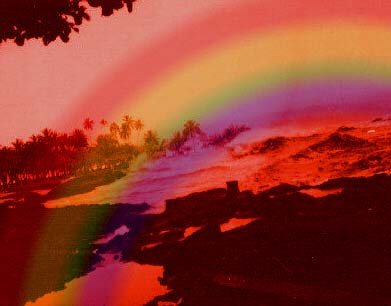 |
.
 |
![]()
Just got this news item appended below from your USA ABC NEWS - Science section web site:
Last week an OZ TV news item showed an Australian Geology Professor from PNG University interviewing survivors of the Tsunami. The survivor reported that as the sea wave swept in it was on fire--as was the air above it.
This ABC article suggests natural organism bio-luminescence was the cause of these flames. I can confirm that any sea voyage around PNG at night is spectacular due to the luminescence of the organisms in the prop wake - but I do have trouble buying that this gave the wave an "appearance" of being on fire. The PNG survivor shown on TV appeared very lucid and was puzzled by his genuine observation of flames in the sea as the tidal wave swept in.
Many bodies were apparently burnt. This is now explained as friction caused by rolling around with sand and debris-- maybe so.
Now local OZ scientists are suggesting natural gas was released from the PNG quake sub-sea fault line - sheets of flames and resultant fires have been reported at times from big seismic events on land around the world (eg late 1800's and early 1900's California) - these were once believed by scientists remote from the event locations to be caused by house gas pipeline ruptures however research proved the craziness of this idea as no such pipelines were in existence in most (99.9%) of such cases - the gas that ignited was possibly hydrogen and methane released along the fault from deep Mantle ultrabasic rocks undergoing phase changes or reaction with water, or release of natural gas from sedimentary sequence reservoirs located along the fault plane, or just possibly these fires involve massive piezo-electric (due to stress in breaking rock crystals) scalar EM energy release along and above the fault plane creating a Tesla style electric flame? A similar scalar EM energy release has been proposed by Bearden and others (see his book Excalibur) for the origin of fault plane quake related "Earth Stress Lights."
Any of the above might apply in the PNG Tsunami case. However as the eye-witness reports are rather anomalous in that flames are not normally associated with Tsunamis. Neither (as far as I am aware) are many burnt bodies normally found after such events. This entire PNG tsunami scenario requires further close detailed analysis. I have tried to get into e-mail comm with the geology professor from PNGU--so far with no success.
Although we disagree on the role of the USGS drilling crew on site some 1000km SE of the tsunami quake site it is just possible they were sent there to gather field data on a quake-tsunami weapon deployment--without knowing what was about to unfold - rather than their drilling holes into a fault plane there leading to the quake initiation on the other side of PNG?
I noticed that the great highly devastating Kobe quake was initiated whilst a top USGS quake team were in Tokyo attending a big seismic symposium. They got into Kobe and carried out a very detailed study of that event which the USGS placed on their web site in prime position; very convenient if you want to see just how your weapon worked in a real deployment.
Having said the above the most likely scenario for this PNG Tsunami is still Natural Cause - but you do have to wonder what really went on that night?Harry Mason
.
Tsunamis typically get triggered by earthquakes. The massive underground movements create fast-moving waves that rise up when they reach shore. (ABCNEWS.com)
It rolled ashore thundering like a jet aircraft taking off, and people watched in horror as the wall of water erased their homes and swept thousands to their deaths. Some thought they were being punished for their sins as the tsunami swept across Papua New Guinea on July 17, leaving only shattered boards where a village once flourished. Others thought a giant explosion caused the wave, which towered more than 40 feet.
Some survivors reported seeing sparks fly from the water and thought the ocean was on fire.
Costas Synolakis, professor of civil engineering at the University of Southern California, led a team of U.S. scientists to Papua New Guinea to see what they could learn from a tsunami that, according to the textbooks, never should have happened.
"It was an eye-opener," Synolakis says.
Synolakis had led other post-tsunami expeditions in the past, but this one was different because the villagers spoke English so the team didn't have to rely on the filtered testimony of government officials.
"Now we could understand the horror directly," he says. But when it was all over, Synolakis was left with questions of his own.
The earthquake that preceded the tsunami had a magnitude of 7, which scientists didn't think was powerful enough to trigger such a devastating wave. Underestimating the threat of tsunamis from even moderate earthquakes could mean much of the west coast of North America is more vulnerable than had been thought.
His team, sponsored by the National Science Foundation, went on a purely scientific expedition, but the mission soon included educating the locals. One top government official pleaded with the scientists to help his people understand they were not being punished "for the impiety of some people," as he put it. So they took time off from the difficult task of reconstructing the tsunami and tried to explain to the locals they weren't to blame. Particularly troubling was the question from a 15-year-old schoolgirl who asked about a "mountain of water with fire sparkles." Many of the victims had what appeared to be severe burns, suggesting that the water was on fire.
The tsunami hit about an hour after sundown, and the waters of the South Pacific are rich with dinoflagellates and other bioluminescent microorganisms that light up when disturbed.
"In the darkness, it may well have caused the water to sparkle like fire," he says. And the burn marks were caused by friction, not fire, as the victims were swept through the turbulent waters.
"I found that most people felt more reassured to hear that this is a natural event and it will happen again sometime in the future" rather than being fed an empty promise that it'll never happen again, Synolakis says.
In a report to the science foundation, team member Emile Okal, professor of geophysics at Northwestern University, notes that there are about 10 magnitude 7 earthquakes every year. Normally they don't produce tsunamis.
"Of the nine large tsunamis that have occurred in the past six years, only the New Guinea one resulted from an earthquake as small as magnitude seven," Okal says.
The wave hit five to 10 minutes after the quake. "It is possible the wave was breaking as it attacked" the narrow spit of land between the villages of Arop and Sisano, Okal says.
But the earthquake was on the beach, not offshore, so what could have caused such a large displacement of water that produced a tsunami?
Okal believes the quake triggered a huge landslide offshore.
"A tsunami is like kicking a bucket of water," he says. "You can make ripples at the surface by kicking or deforming the bottom of the bucket. This is what happens during an earthquake. The ocean floor is deformed and the water is kicked around."
An offshore landslide could do the same thing by "kicking the bucket" and changing the contour of the bottom, "which gives rise to extremely turbulent motions."
If that scenario is correct-"we cannot explain it otherwise," Okal says-then other areas of the world are more vulnerable than had been thought. He cites, for example, the west coast of Canada, and particularly the Fraser River basin. That large river has deposited a mountain of sediments along the coast.
"All that sediment just piles up in structures that are probably quite unstable," he says.
A moderate earthquake might be all it would take to cause the mountain to slump, generating a powerful tsunami.
The same scenario could also play out in Southern California, according to Synolakis, who lives in the coastal community of Venice. A moderate quake could cause an offshore landslide, which could send a wall of water crashing into the thousands of people who visit those beaches on summer days.
The death toll in Papua New Guinea may never be known precisely, but it is expected to approach 3,000, making the tsunami one of the most deadly of the century. The coastal land there is so flat that the victims "had no place to run," Okal says. Their best hope is to build their homes farther back from the beach, but that message never seems to catch on, even in sophisticated parts of the world like Southern California.
When the tsunami hits, the scientists advise, run as far from the beach as possible-if there's time. And if that won't do it, climb a tree, preferably one with deep roots. But if Papua New Guinea is like just about any place else, by the time it happens again, those warnings will have long been forgotten.
Science writer Lee Dye's column appears Wednesdays on ABCNEWS.com.
VENTURE INTO THE VAULT OF WONDERS . .
PLEASE RETURN: THIS SITE CONSTANTLY CHANGES
OPTIONAL
MIDI
|
|---|
|
 .
.

.